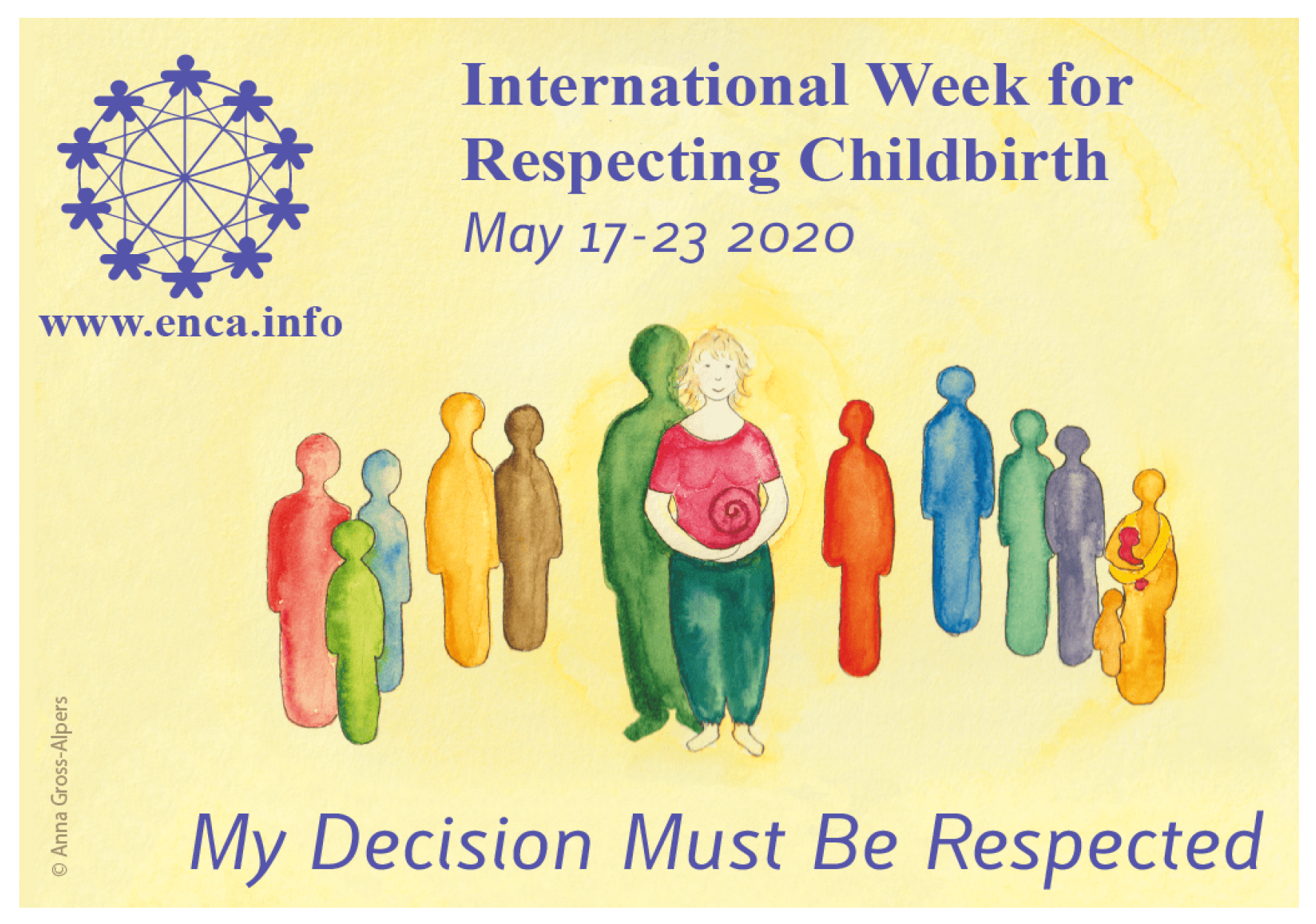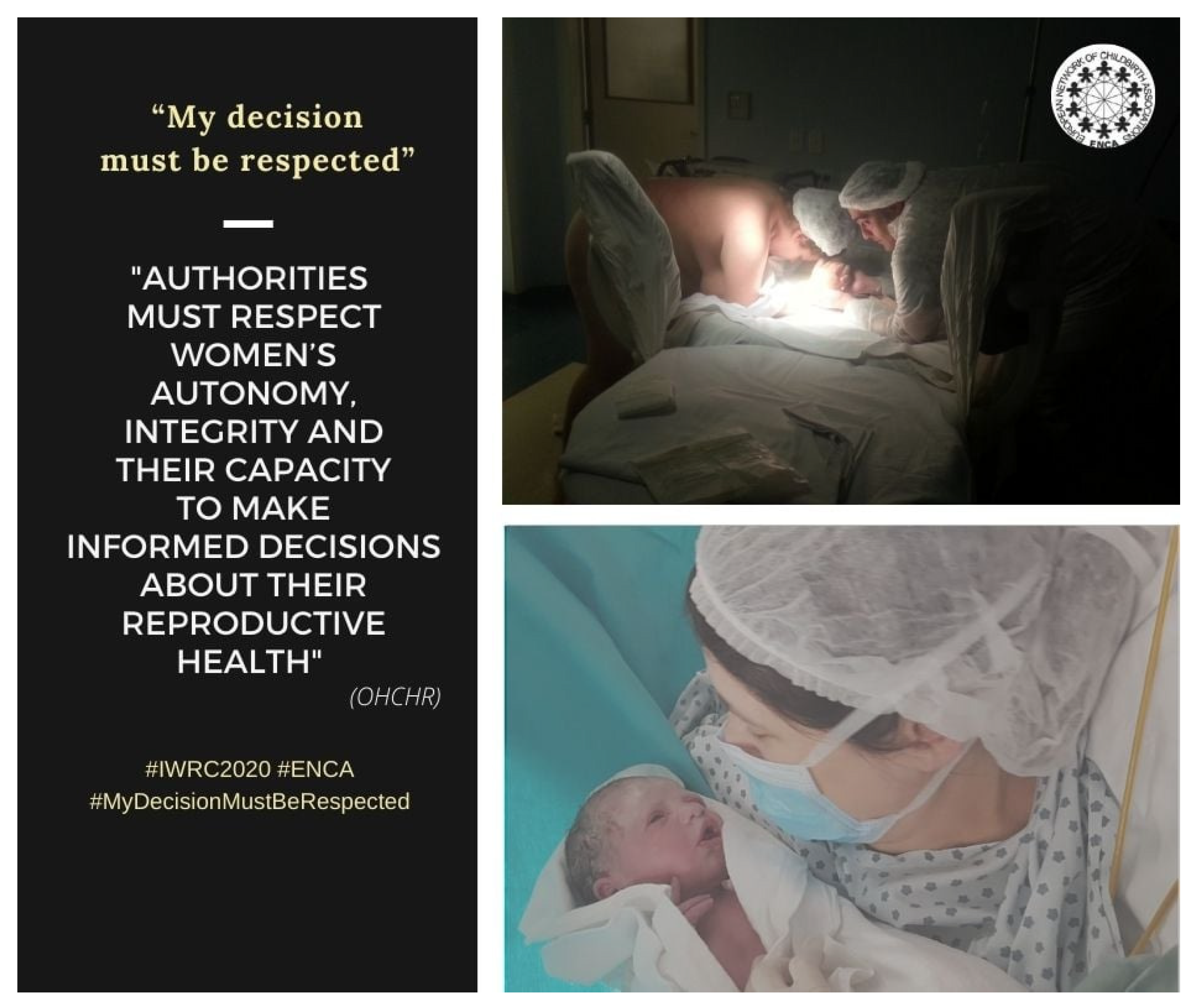“To Change the World, We Must First Change the Way the Babies Are Being Born”: Childbirth Activism in Europe
Abstract
1. Introduction
Childbirth Activism: An Overview
2. Materials and Methods
3. Results and Discussion
3.1. Childbirth Organizations from Spain, Portugal and The Netherlands
3.2. International Network and Campaigns
3.2.1. The European Network of Childbirth Associations
3.2.2. International Week for Respecting Childbirth
- The Economics of Birth (2012);
- Do not disturb! Birth in Progress (2013);
- Birth is Empowering! (2014);
- Continuous love and support for me and my baby! (2015);
- My decision, my body, my baby! (2016);
- 40 weeks? Birth has a right time, not a scheduled time (2017);
- Less Interference, More Care (2018);
- The power for birth is IN you (2019);
- My decision must be respected (2020);
- Respect for the needs of mother and her baby in any situation (2021);
- Better birth for a better future (2022);
- Supporting Birth = Supporting Families (2023);
- Hard Data, Mother’s Choice, Flexible Care (2024).
4. Conclusions
Funding
Institutional Review Board Statement
Informed Consent Statement
Data Availability Statement
Conflicts of Interest
| 1 | Although this quotation is attributed to Michel Odent on various occasions, encapsulating the idea that the author develops in several works and lectures, it is difficult to define its exact origin. In an interview published in 2023, Michel Odent mentioned he had written this phrase “a long time ago”, “perhaps in 1976”, without specifying its origin (Ramos 2023, p. 31). |
| 2 | In 2015, this fact motivated an urgent recommendation from the Committee for the Elimination of Discrimination against Women (CEDAW) to the Portuguese government: https://plataformamulheres.org.pt/site/wp-content/ficheiros/2015/11/RecomendacoesCEDAW-PT-TraducaoPpDM30Nov2015.pdf (accessed on 14 July 2024). |
| 3 | Associação Portuguesa pelos Direitos da Mulher na Gravidez e Parto. |
| 4 | Alliance Française pour l’Accouchement Respecté. |
References
- Akrich, Madeleine, Máire Leane, Celia Roberts, and João Arriscado Nunes. 2014. Practising childbirth activism: A politics of evidence. BioSocieties 9: 129–52. [Google Scholar] [CrossRef]
- Barata, Catarina, Dulce Morgado Neves, and Mário Santos. 2020. COVID-19 Containment Measures, Perinatal Experiences, and the Fight for Childbirth Rights in Portugal. Medical Anthropology Quarterly—Blog on COVID-19 Responses. Hoboken: Willey. [Google Scholar]
- Bergström, Malin. 2011. Continuous support in labour has beneficial effects for mother and baby. BMJ Evidence-Based Medicine 16: 182–83. [Google Scholar] [CrossRef] [PubMed]
- Bohren, Meghan A., Gustav Justus Hofmeyr, Carol Sakala, Rieko K. Fukuzawa, and Anna Cuthbert. 2017. Continuous support for women during childbirth. Cochrane Database Systematic Review 7: CD003766. [Google Scholar] [CrossRef] [PubMed]
- Conrad, Peter. 2007. The Medicalization of Society: On the Transformation of Human Conditions into Treatable Disorders. Baltimore: Johns Hopkins University Press. [Google Scholar]
- Davis-Floyd, Robbie. 2001. The technocratic, humanistic, and holistic paradigms of childbirth. International Journal of Gynaecology and Obstetrics 75: S5–S23. [Google Scholar] [CrossRef] [PubMed]
- Denzin, Norman. 1978. The Research Act: A Theoretical Introduction to Sociological Methods. New York: Mc Graw-Hill. [Google Scholar]
- Euro-Peristat Project. 2013. European Perinatal Health Report. Health and Care of Pregnant Women and Babies in Europe in 2010. Paris: INSERM. [Google Scholar]
- Euro-Peristat Project. 2018. European Perinatal Health Report. Core Indicators of the Health and Care of Pregnant Women and Babies in Europe in 2015. Paris: INSERM. [Google Scholar]
- Fedele, Anna. 2015. Spiritual Mothering. In Portugal: Some Initial Reflections from an Anthropological Perspective. ISSRC Working Paper. Lausane: UNIL. [Google Scholar]
- Hodnett, Edward, Shawn Gates, Carol Sakala, and Gustav Justus Hofmeyr. 2013. Continuous support for women during childbirth. Cochrane Database of Systematic Reviews 7: CD003766. [Google Scholar] [PubMed]
- Iravani, Mina, Elahe Zarean, Mohsen Janghorbani, and Masod Bahrami. 2015. Women’s needs and expectations during normal labor and delivery. International Journal of Health Promotion and Education 4: 31–37. [Google Scholar]
- McCourt, Christine, and Fiona Dykes. 2010. From Tradition to Modernity: Time and Childbirth in Historical Perspective. In Childbirth, Midwifery and Concepts of Time. Edited by Christine McCourt. New York: Berghahn Books. [Google Scholar]
- Millward, Peter, and Shaminder Takhar. 2019. Social Movements, Collective Action and Activism. Socioilogy 53: 1–12. [Google Scholar] [CrossRef]
- Neves, Dulce Morgado, and Catarina Barata. 2023. Direitos, resistências e mudanças nos cuidados perinatais durante a pandemia por COVID-19 em Portugal: O papel e a ação da Associação Portuguesa pelos Direitos da Mulher na Gravidez e Parto. Miscellanea 19: 48–53. [Google Scholar]
- Oakley, Ann. 2016. The sociology of childbirth: An autobiographical journey through four decades of research. Sociology of Health & Illness 38: 689–705. [Google Scholar]
- Odent, Michel. 2015. Do We Need Midwives? London: Pinter & Martin. [Google Scholar]
- Perined. 2021. Perinatale zorg in Nederland anno 2020—Duiding door landelijke perinatale audit en registratie. Utrecht: Perined. [Google Scholar]
- Pintassilgo, Sónia, and Helena Carvalho. 2017. Trends and consequences of the technocratic paradigm of childbirth in Portugal: A population-based analysis of birth conditions and social characteristics of parents. Sexual and Reproductive Healthcare 13: 58–67. [Google Scholar] [CrossRef] [PubMed]
- Ramos, Leiva. 2023. Michel Odent—‘Esquecemos completamente quais são as necessidades básicas da mulher em trabalho de parto’. Miscellanea 19: 25–31. [Google Scholar]
- Santos, Mário J. D. S., and Dulce Morgado Neves. 2021. A Manifest against the Homogenisation of Childbirth Experiences: Preserving Subjectiveness in a Large Dataset of the «Babies Born Better» Survey. Social Sciences 10: 388. [Google Scholar] [CrossRef]
- Smith, Valerie. 2014. Salutogenically focused outcomes in systematic reviews of intrapartum interventions: A systematic review of systematic reviews. Midwifery 30: 151–56. [Google Scholar] [CrossRef] [PubMed]
- Todres, Les, Kathleen T. Galvin, and Immy Holloway. 2009. The humanization of healthcare: A value framework for qualitative research. International Journal of Qualitative Studies on Health and Well-Being 4: 68–77. [Google Scholar] [CrossRef]
- Wang, Haidong, Chelsea A. Liddell, Matthew M. Coates, Meghan D. Mooney, Carly E. Levitz, Austin E. Schumacher, Henry Apfel, Marissa Iannarone, Bryan Phillips, Katherine T. Lofgren, and et al. 2014. Global, regional, and national levels of neonatal, infant, and under-5 mortality during 1990–2013: A systematic analysis for the Global Burden of Disease Study 2013. Lancet 384: 957–79. [Google Scholar] [CrossRef] [PubMed]
- White, Joanna, and Maria Johanna Schouten, eds. 2014. Normal Birth: Experiences from Portugal and Beyond. Braga: CICS. Lisbon: CRIA. [Google Scholar]
- World Health Organization (WHO). 2014. The Prevention and Elimination of Disrespect and Abuse during Facility-Based Childbirth: WHO Statement. Geneva: WHO. [Google Scholar]




Disclaimer/Publisher’s Note: The statements, opinions and data contained in all publications are solely those of the individual author(s) and contributor(s) and not of MDPI and/or the editor(s). MDPI and/or the editor(s) disclaim responsibility for any injury to people or property resulting from any ideas, methods, instructions or products referred to in the content. |
© 2024 by the author. Licensee MDPI, Basel, Switzerland. This article is an open access article distributed under the terms and conditions of the Creative Commons Attribution (CC BY) license (https://creativecommons.org/licenses/by/4.0/).
Share and Cite
Neves, D.M. “To Change the World, We Must First Change the Way the Babies Are Being Born”: Childbirth Activism in Europe. Soc. Sci. 2024, 13, 490. https://doi.org/10.3390/socsci13090490
Neves DM. “To Change the World, We Must First Change the Way the Babies Are Being Born”: Childbirth Activism in Europe. Social Sciences. 2024; 13(9):490. https://doi.org/10.3390/socsci13090490
Chicago/Turabian StyleNeves, Dulce Morgado. 2024. "“To Change the World, We Must First Change the Way the Babies Are Being Born”: Childbirth Activism in Europe" Social Sciences 13, no. 9: 490. https://doi.org/10.3390/socsci13090490
APA StyleNeves, D. M. (2024). “To Change the World, We Must First Change the Way the Babies Are Being Born”: Childbirth Activism in Europe. Social Sciences, 13(9), 490. https://doi.org/10.3390/socsci13090490





